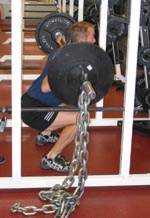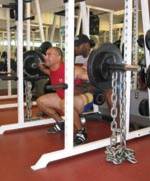A Closer Look At BFS ChainsScientific research is confirming the ever-increasing value of lifting chains in helping athletes achieve their physical potentialBy Kim Goss Published: Fall 2003 The BFS program has been building champions for 25 years. Over this time the basic BFS training principles have changed little—after all, who would dispute the value of a respected program that produces hundreds of high school state championships in major sports? That’s why when something is added to the BFS program, it’s big news. The something new this past year is lifting chains. Although widespread use of chains for weight training is a recent practice, chains have been around since the early days of modern resistance training, and over 30 years ago Nautilus inventor Arthur Jones wrote about experimenting with lifting chains. Jones didn’t pursue chains, deciding instead to use a shell-shaped cam to vary resistance on his machines. Although Jones is credited with popularizing variable resistance training, the need for such training was identified over 100 years ago. On October 15, 1901, Max Herz of Vienna was awarded a patent for his prototype of an “irregular-faced cam.” Many years later, Jones’ writings on the subject reintroduced lifting chains to athletes and coaches. One such coach was Jim Schmitz. Jim Schmitz, who was featured in our Spring 2002 issue, is one of the most accomplished Olympic weightlifting coaches in the world. In his early years as a weightlifter Schmitz experimented with lifting chains on core exercises, but decided that carrying heavy chains to the gym was simply too inconvenient. More recently, powerlifters—especially the elite athletes coached by powerlifting guru Louie Simmons—have been experimenting with chains. The Straight Truth about Strength Curves The theory of variable resistance is that because you’re stronger (or weaker) at different points in an exercise, the best strength training devices should increase the resistance at the points at which you are strongest. Herz explained in his patent how his “cam” would achieve this: “ . . . in working with such apparatuses, during the whole movement, the muscles shall be exerted in accordance with their momentary tension or pulling force.” This meant there would be no sticking points so the muscles would be working hard throughout the entire lift. A strength curve is a mathematical model that represents how much force can be produced at specific joint angles. An “ascending” strength curve exists when you can display more force as you extend the joints; exercises such as deadlifts, squats, bench presses and military presses have ascending strength curves. Chains would be valuable for these exercises because the increasing resistance during the strongest joint angles would make the exercise feel “smooth” through the entire movement. A descending strength curve exists when you can display more force as you flex a joint. An adductor (inner thigh) pull with cables or a machine would have a descending strength curve, as you can display more force when the legs are closest together. Some exercises have ascending-descending strength curves, which means that you can display more strength at the mid-range of the movement. Chins and standing biceps curls are such exercises. Using chains for exercises with descending or ascending-descending strength curves would not be very useful, as the chains would apply the most resistance in the parts of the exercise where you would be weakest. One important point to consider about strength curves concerns the effects of muscular fatigue. For a bench press, as the set progresses fatigue would make the athlete less strong at the finish of the exercise than at the start. Let’s say an athlete can bench press 200 pounds and is trying to perform as many reps as possible with 160 pounds. For the first five reps the weight feels lighter at the finish, for the next five reps the weight feels even through the entire movement, and at about the 15th rep the athlete will only able to lift the barbell a few inches off the chest but cannot finish the lift. The practical application of the fatigue factor is that chains would not be appropriate for bodybuilding protocols that require high repetitions, such as reps of 12-15, because the resistance would be too heavy at the end range of motion. Because the BFS program emphasizes lower reps than do bodybuilding programs, chains would be a good training method, especially during the first week of the BFS training cycle, which uses set-rep protocols of 3x3. It would be less effective during the fourth week, in which sets of 10-8-6 are performed for many core lifts. Moving Beyond Nautilus When I trained for several months on the Nautilus machines in the early ‘70s, I was disappointed that the exercises never felt “smooth” throughout the entire lift. I was told by the gym instructors that this was because my earlier training with free weights had altered my natural force curves, and that extended Nautilus-only training would eventually make my muscles balanced and the exercises would feel perfect. In reality, I believe the problem was that the machines I was using had force curves that were designed on the basis of 1-rep maxes, not the multiple repetitions I was using and the manufacturers recommended. There have been various attempts to provide appropriate resistance for all types of strength curves. One former Mr. Universe and gym owner changed his Nautilus machines to use circular pulleys and found they worked much better. David, an exercise equipment company in Sweden, designed its machines to adjust to the curves displayed during higher repetitions. In a David leg extension, for example, there would be minimal resistance at the end of the exercise, exactly opposite of how the cam works on a Nautilus machine. Another refinement was isokinetic machines, which allow the athlete to perform exercises at one movement speed. With such machines, resistance is applied only when movement occurs, so that no work is being performed during the isometric (pause) and eccentric (lowering) portions of the exercise. This is a major problem. Research has shown that the eccentric portion of an exercise is the most effective type of muscular contraction for developing strength, and eccentric strength is important for developing the ability to control the forces that occur in sports, such as landing during a jump in volleyball or basketball. “Also, because these machines only allow for one movement speed and because acceleration is an important component to the development and maintenance of power, these machines would be detrimental to athletic performance,” says Jerry Telle, a personal trainer from Littleton, Colorado, who has done extensive research on strength curves. Explosive Advantages Chains improve explosive strength. In squats, chain training will teach you to drive to the top of the lift because you cannot reduce force as you can with a regular barbell. After a few weeks of training athletes with chains, coaches often report not only increases in 1-maxes, but also more acceleration while lifting, which can translate into a more explosive athlete. In addition to adding resistance to squats and bench presses, chains are useful in quick lifts such as cleans, snatches and even jerks. One strong advocate of using chains for the quick lifts is Doug Briggs, a faculty member at New Mexico State University and president of the American Weightlifting Association. The idea to use chains occurred to him in May of 2002 when his team was training at Scott Warman’s Pro-Gym in El Paso, Texas. “I was sitting on a bench looking at the chains hanging off of a bench press bar and the thought occurred to me that this might be something I could adapt to Olympic weightlifting,” says Briggs. Brigg’s first thought was how to adapt the chains so that they wouldn’t get in the way of the feet or interfere with the lift. To ensure safety, he believed it was important to have the chains attached as far as away from the inside collars of a barbell as possible. (To do this wi |
 |
|
2002 Olympic gold medalist (in the skeleton event) Jim Shea doing intense reps with chains, a vital part of his training workout. |
 |
|
2002 Olympic silver medalist (bobsled) Bill Schuffenhauer using a two-chain method with a lighter plate weight. Training mate Ivan Radcliffe spotting. |